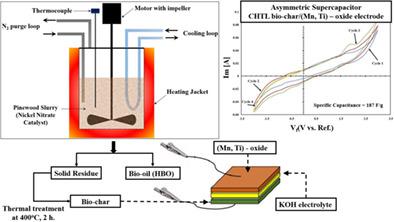当前位置:
X-MOL 学术
›
Int. J. Energy Res.
›
论文详情
Our official English website, www.x-mol.net, welcomes your
feedback! (Note: you will need to create a separate account there.)
Catalytic HTL‐derived biochar and sol‐gel synthesized (Mn, Ti)‐oxides for asymmetric supercapacitors
International Journal of Energy Research ( IF 4.3 ) Pub Date : 2020-09-17 , DOI: 10.1002/er.5938 Vinod S. Amar 1 , Joseph D. Houck 1 , Rajesh V. Shende 1
International Journal of Energy Research ( IF 4.3 ) Pub Date : 2020-09-17 , DOI: 10.1002/er.5938 Vinod S. Amar 1 , Joseph D. Houck 1 , Rajesh V. Shende 1
Affiliation

|
In this study, hydrothermal liquefaction (HTL)‐derived biochar is investigated as electrode material with sol‐gel‐derived (Mn, Ti)‐oxide electrode for asymmetric supercapacitor. To generate biochar, pinewood flour was used as an example biomass feedstock for HTL, which was carried out at 300°C and 1500 psi for 1 hour in the absence and presence of the Ni‐nitrate (Ni[NO3]2.6H2O) catalyst. After HTL, different products were analyzed by TOC analyzer, HPLC, and GCMS, and mass yield/carbon balance was determined. Solid residue recovered after HTL or catalytic HTL (CHTL) was thermally treated at 400°C for 2 hours to obtain biochar, which was characterized using BET surface area analyzer and SEM/EDX, and utilized as one of the electrodes. To fabricate asymmetric supercapacitor (ASC), (Mn,Ti)‐oxide electrode material was synthesized using sol‐gel technique with Mn:Ti precursor ratio of 30:70 wt%. As‐synthesized gels were aged, dried, and calcined with a 2‐step heating process (step‐1: heating to 500°C and cooling to 50°C, and step‐2: heating to 1000°C with soak time of 2 hours and cooling to 50°C), which were characterized by powdered X‐ray diffraction and BET analysis. Asymmetric supercapacitors were fabricated with HTL/CHTL derived biochar/(Mn,Ti)‐oxide electrodes and KOH electrolyte, and tested with cyclic voltammetry to determine specific capacitance. ASC fabricated with CHTL‐derived biochar electrode showed a higher specific capacitance of 187 F/g.
中文翻译:

催化HTL衍生的生物炭和溶胶-凝胶合成的(Mn,Ti)-氧化物,用于不对称超级电容器
在本研究中,对水热液化(HTL)衍生的生物炭作为电极材料进行研究,该电极材料采用溶胶-凝胶衍生的(Mn,Ti)氧化物电极作为不对称超级电容器。为了生成生物炭,使用松木粉作为HTL的示例生物质原料,该原料在不存在和存在硝酸镍(Ni [NO 3 ] 2 .6H 2的情况下于300°C和1500 psi下进行1小时)O)催化剂。HTL后,通过TOC分析仪,HPLC和GCMS分析不同的产物,并确定质量收率/碳平衡。将HTL或催化HTL(CHTL)回收的固体残留物在400°C下热处理2小时以获得生物炭,使用BET表面积分析仪和SEM / EDX对其进行表征,并用作电极之一。为了制造不对称超级电容器(ASC),使用溶胶-凝胶技术以Mn:Ti前驱体比率为30:70 wt%合成了(Mn,Ti)-氧化物电极材料。将合成的凝胶进行老化,干燥和煅烧,分两步加热(第一步:加热至500°C,冷却至50°C,第二步:加热至1000°C,均热时间为2小时并冷却至50°C),其特征在于粉末X射线衍射和BET分析。用HTL / CHTL衍生的生物炭/(Mn,Ti)-氧化物电极和KOH电解质制造不对称超级电容器,并用循环伏安法测试以确定比电容。用源自CHTL的生物炭电极制造的ASC的比电容更高,为187 F / g。
更新日期:2020-11-15
中文翻译:

催化HTL衍生的生物炭和溶胶-凝胶合成的(Mn,Ti)-氧化物,用于不对称超级电容器
在本研究中,对水热液化(HTL)衍生的生物炭作为电极材料进行研究,该电极材料采用溶胶-凝胶衍生的(Mn,Ti)氧化物电极作为不对称超级电容器。为了生成生物炭,使用松木粉作为HTL的示例生物质原料,该原料在不存在和存在硝酸镍(Ni [NO 3 ] 2 .6H 2的情况下于300°C和1500 psi下进行1小时)O)催化剂。HTL后,通过TOC分析仪,HPLC和GCMS分析不同的产物,并确定质量收率/碳平衡。将HTL或催化HTL(CHTL)回收的固体残留物在400°C下热处理2小时以获得生物炭,使用BET表面积分析仪和SEM / EDX对其进行表征,并用作电极之一。为了制造不对称超级电容器(ASC),使用溶胶-凝胶技术以Mn:Ti前驱体比率为30:70 wt%合成了(Mn,Ti)-氧化物电极材料。将合成的凝胶进行老化,干燥和煅烧,分两步加热(第一步:加热至500°C,冷却至50°C,第二步:加热至1000°C,均热时间为2小时并冷却至50°C),其特征在于粉末X射线衍射和BET分析。用HTL / CHTL衍生的生物炭/(Mn,Ti)-氧化物电极和KOH电解质制造不对称超级电容器,并用循环伏安法测试以确定比电容。用源自CHTL的生物炭电极制造的ASC的比电容更高,为187 F / g。











































 京公网安备 11010802027423号
京公网安备 11010802027423号